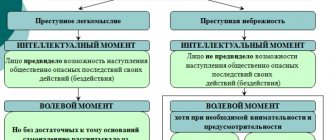Criminals commit illegal acts with different forms of guilt. One of the most common forms is intent. When I worked in the prosecutor's office, I often had to accompany assistant prosecutors during investigative activities and trials. From my own experience and general judicial practice, I can say that intent plays an important role in sentencing defendants. The fact of malicious intent in criminal law is punished most severely, even in cases where the accused did not have time to commit the crime he planned.
Types of intent, its influence on the action of the culprit and the outcome of the crime are discussed in Art. 25 of the Criminal Code of the Russian Federation. In Art. 26 of the Criminal Code regulates the lack of intent and the consequences for the culprit. In cases where there is no guilt on the part of the person who committed the illegal actions, responsibility is removed from him, and criminal prosecution is terminated.
What it is
It is represented by the attitude of the offender himself towards the committed act. Additionally, it is used to evaluate the consequences of a crime relative to the level of a person’s psyche.
According to Art. 25 and wine comes in two forms:
Free legal consultation
+8 800 100-61-94
- committing a crime through negligence;
- intentional act.
Attention! When bringing charges, it is taken into account whether the citizen intentionally committed certain illegal actions. Thanks to a competent determination of guilt, the optimal punishment for the criminal is revealed.
The concept of intent
There are two types of guilt: intent and negligence. According to statistics, the share of the former in the total share of crimes is more than 90%. This suggests that only one in ten criminal acts is due to negligence.
Intent is a mental attitude in which a person, during a crime, understands the danger of his actions, anticipates the possibility of socially dangerous consequences, desires them, or does not consciously prevent it. Consciousness of wrongfulness is often considered together with intent. It means that a person consciously committed a crime, while understanding that he would face punishment.
The content and types of intent do not include this concept. The consciousness of wrongfulness is closely related to the characteristics of the object of the crime. When an intentional crime is committed, it should be considered in accordance with the consciousness of the object of the offense, even if in fact the act was aimed at a different purpose. For example, if a criminal wanted to kill a law enforcement officer, but in a real situation causes harm to a person who is not on duty, the act will be classified as an attempt on the life of a law enforcement officer.
Intent and its types in criminal law are of great importance both for the detection of crimes and for compliance with the rule of law. Desire as a factor of intent represents the desire for a certain result. The criminal, when committing an offense, receives inner pleasure. In this case, the expression “the end justifies the means” is ideal. The criminal goes to great lengths to get the desired consequences.
Types in criminal law
According to the law, a crime can be committed intentionally or through negligence. Correct classification allows the judge to determine whether aggravating or mitigating circumstances can be used.
The most common type of guilt is intent, which can be:
- straight;
- indirect.
The offender may think about the planned act in advance or commit the crime intentionally. Sudden intent can be simple or affective. Additionally, it is divided into specific or indefinite, as well as alternative.
It is also useful to read: How to behave in court
Straight
Direct intent is a situation where a crime is committed with direct intent, if the offender is aware of the negative consequences for society from his actions or inaction, but does not use various methods to prevent the situation. A criminal intentionally wants to commit a crime with the understanding that it will negatively impact another person, group of people, or society. Such people realize that they are committing illegal actions.
In judicial practice, there are often situations when a person does not know about the consequences at the time of committing a crime. Ignorance of legal requirements is not a basis for exemption from liability. Therefore, such crimes are still considered intentional.
If there is direct intent, the criminal is aware of two scenarios:
- he understands that his actions will inevitably lead to negative consequences, since, for example, a shot in the head almost always ends in the death of the victim;
- realizes that certain actions can lead to unforeseen negative consequences, for example, the theft of jewelry often ends in murder or serious injury to the victim, although the criminal did not initially plan to contact the owner of the apartment.
Important! Direct intent can be selfish, so it has a material nature. The main purpose of such a crime is to cause harm to another person or object for the purpose of obtaining profit.
Indirect
It assumes that the offender, at the time of committing the criminal act, was aware that his actions could lead to negative consequences, and could also prevent them, but allowed them to occur due to indifference or other reasons. With such intent, dangerous consequences are represented as a side effect, since the offender committed certain actions for a different purpose.
Indirect intent is presented in the following forms:
- the criminal is indifferent to the negative consequences of his actions, and therefore does not worry about the life and health of other people;
- the citizen deliberately allowed such consequences.
Many offenders rely on serendipity and luck when committing criminal acts.
By time of appearance
According to the time of detection, intent can be:
- pre-thought out;
- suddenly appeared.
The main purpose of determining specific intent is to identify the reasons and motives for committing a crime. The most dangerous situation is considered to be when the criminal deliberately and premeditates the criminal act. He plans his actions, forms a plan, chooses a place and a weapon, and also calculates various options. Therefore, it is quite difficult to investigate such a crime due to the lack of numerous evidence.
Reference! A criminal who commits a crime with premeditated intent has criminal inclinations, so the judge assigns the most severe punishment to him.
With sudden intent, a crime is committed without prior planning. Its varieties include:
- Simple . The offense is committed either immediately or within a few days after the emergence of a specific thought. The person is mentally balanced and aware of the consequences of his criminal acts. Often after such actions there are many clues left that are useful for the investigation.
- Affective . The crime is committed by a citizen who, for various reasons, is in a specific mental state, and therefore cannot fully control his words and actions. If there is evidence of a state of passion, the judge often makes a more lenient decision.
Each crime is considered individually, but knowledge of the presence of direct or indirect intent directly affects the sentence. Often, when premeditated intent is identified, it is discovered that the criminal was considering various options to minimize negative consequences for himself.
For example, if a person conceived a murder, but decided to implement his plans during a fight in order to mitigate the punishment, then this indicates the extreme danger of the person’s thinking. For him, murder is not any serious step in life, so he thinks exclusively about the consequences for himself, and not for the people around him and society.
It is also useful to read: Presumption of innocence
By degree of certainty
Specific intent presupposes that the offender is well aware of the consequences of his actions and is aware of the harm he causes. It is divided into two varieties:
- Simple . Before committing a crime, a citizen foresaw what consequences he would have to face. Therefore, he sought to achieve only one consequence. For example, a person decides to kill his neighbor. To do this, he takes a pistol and shoots him in the head, therefore leaving no room for alternative options, represented by causing serious or moderate harm to the health of a neighbor.
- Alternative . A person does not want to kill a neighbor with whom he constantly conflicts, but during a fight he delivers fierce blows that can cause death. As a result, your neighbor could die or be seriously injured.
Uncertain intent is characterized by the following characteristics:
- a person who decides to commit a crime understands the danger of such actions;
- but he does not care how serious the harm done will be;
- a citizen cannot determine the clear consequences of a criminal act.
For example, a man wants to harm the health of his neighbor, for which he gets involved in a fist fight, but cannot assess how serious damage he can cause. After the battle ends, the neighbor may die or receive some kind of injury.
Therefore, the instigator of a fight knows that he can beat the other person, but does not know how serious the damage will be. Another example is theft, since a thief who enters someone else’s apartment through illegal means to obtain material gain cannot know in advance how much money he will be able to take.
An alternative intent is that the citizen assumes the likelihood of several consequences occurring at once, which have equal chances.
For example , if you shoot a person with a pistol, you can kill, miss, or cause serious harm to health. When rendering a verdict, the judge evaluates the actual consequences.
Planned and sudden
There are several other types of intentional acts in criminal law. Based on the time of origin of the idea of criminal acts, the intent can be planned and sudden.
The first is characterized by the desire to break the law some time after the desire arises. Planned acts that confirm the cynical nature of the crime are much more dangerous than sudden ones. A distinctive feature of planned actions is considered to be prepared mental acts before a criminal event (the reason that prompted the crime, the choice of the object of the attack).
Here, the incentive to action is separated from criminal events by a time interval, during which the person breaking the law becomes more decisive every minute. It is believed that such deliberate actions confirm the persistent antisocial nature of the subject. It is no coincidence that it is precisely this feature that makes it possible to consider a planned crime to be a greater threat than one committed suddenly.
A planned crime deserves a more severe punishment. Such a judgment should not be taken as an evaluation criterion acceptable for each case of criminal attacks. In practice, a sudden desire to commit a crime can be more serious than actions thought out in advance.
A sudden appearance is considered to be a type that is performed instantly or in a short period of time. In turn, the view is divided into simple and affected:
- With simple sudden intent, the subject’s desire to break the law appeared in his normal psychological state and was accomplished by him immediately or after a short time.
- The second is determined by the mental state of the perpetrator, in which the desire to break the law appeared. The reason that prompted the subject to commit a crime is humiliating actions addressed to the perpetrator or close relatives. They occur suddenly or after a long period of offensive attacks and lead to stress for the perpetrator, who does not control his will. Such circumstances mitigate liability for criminal acts.
For example, a criminal, in response to a legitimate demand to stop hooliganism, picks up a stick from the ground and kills the person who made the remark, without understanding what he is doing, will suffer a more severe punishment. But at the same time, a needlessly humiliated citizen who did not take revenge, but after some time still took the life of the offender, suffers a less severe punishment. Here the invented plan of action in the second case was more difficult for the subject than for the one who acted suddenly.
Features of indirect intent
A crime is considered committed with indirect intent if a person was aware of the social danger, foresaw the possibility of negative consequences, did not want them, but consciously allowed them or remained indifferent.
Direct intent and indirect intent are similar in terms of awareness of public danger. But the second factor - foreseeing the possibility of consequences dangerous to society - distinguishes the types of intent in criminal law. With indirect intent, the inevitability of consequences becomes impossible, since it is a sign of only a direct type of intent. In addition, the premonition of the possibility of dangerous consequences for society with indirect intent differs in the nature of the premonition.
With direct intent, the criminal sees a greater likelihood of serious consequences, and with indirect intent, a lower probability. However, there is a more real possibility of a socially dangerous result.
Types of indirect intent determine the mental attitude of the perpetrator to the possibility of certain consequences occurring, that is, the person allows them. Because of this, this type of intent is possible only in case of material offenses, since the consequences here are presented as a mandatory feature. Crimes of a formal nature can only be of direct intent.
Intent, its forms and types are the most important factors in correctly qualifying a crime, assessing its severity, as well as establishing punishment for the perpetrator. Before determining under which article to judge a person, it is necessary to take into account all the reasons: the type of intent, the motive for the crime, the circumstances under which it was committed, etc.
From a practical point of view, types of intent in criminal law serve for the correct qualification of offenses with material elements. When direct intent is established, in relation to grave consequences that did not occur due to various circumstances, the act is defined as an attempt to commit another, more dangerous crime. With indirect intent in the same situation, the act is qualified as a completed crime depending on the actual result.
Intellectual element of intent
Types of intent are not fundamental factors when dividing this concept into elements. There are two types of intent: intellectual and indirect. Both are general, and apply equally to both direct and indirect intent.
The intellectual element reflects the consciousness of the subject of the crime. It is formed by two factors: awareness of the public danger when committing an offense and anticipation of the consequences. In criminal law, attention is paid to the fact that the intellectual element of direct intent is, to a greater extent, the consciousness of the wrongfulness of the act and the inevitability of the consequences.
Indirect intent in this understanding is distinguished by the fact that the person committing the crime is able to foresee the real possibility of the consequences occurring, and does not interfere with this or is indifferent.









